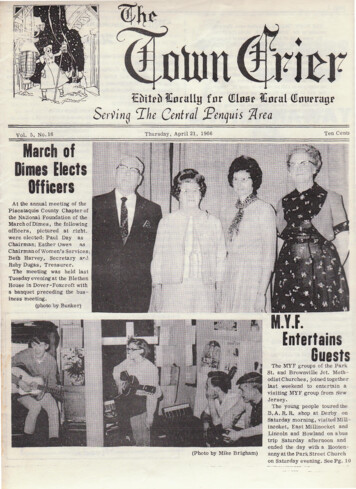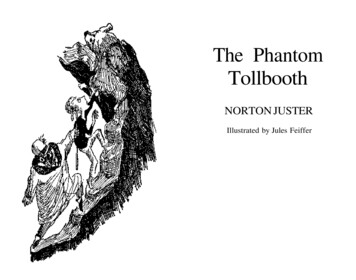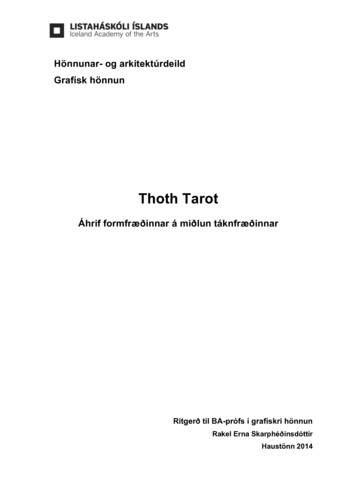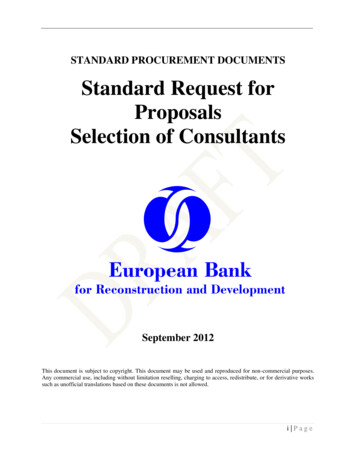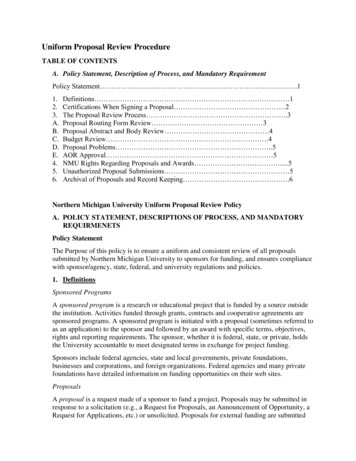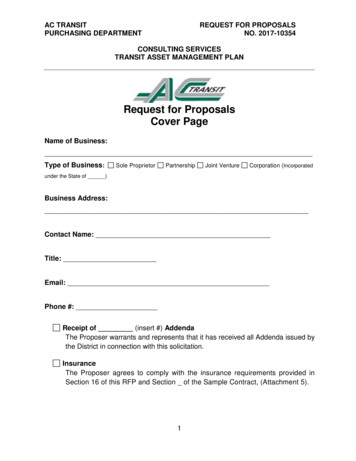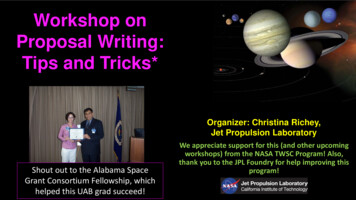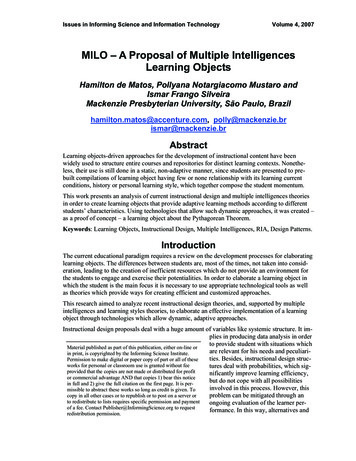
Transcription
Issues in Informing Science and Information TechnologyVolume 4, 2007MILO – A Proposal of Multiple IntelligencesLearning ObjectsHamilton de Matos, Pollyana Notargiacomo Mustaro andIsmar Frango SilveiraMackenzie Presbyterian University, São Paulo, Brazilhamilton.matos@accenture.com, ng objects-driven approaches for the development of instructional content have beenwidely used to structure entire courses and repositories for distinct learning contexts. Nonetheless, their use is still done in a static, non-adaptive manner, since students are presented to prebuilt compilations of learning object having few or none relationship with its learning currentconditions, history or personal learning style, which together compose the student momentum.This work presents an analysis of current instructional design and multiple intelligences theoriesin order to create learning objects that provide adaptive learning methods according to differentstudents’ characteristics. Using technologies that allow such dynamic approaches, it was created –as a proof of concept – a learning object about the Pythagorean Theorem.Keywords: Learning Objects, Instructional Design, Multiple Intelligences, RIA, Design Patterns.IntroductionThe current educational paradigm requires a review on the development processes for elaboratinglearning objects. The differences between students are, most of the times, not taken into consideration, leading to the creation of inefficient resources which do not provide an environment forthe students to engage and exercise their potentialities. In order to elaborate a learning object inwhich the student is the main focus it is necessary to use appropriate technological tools as wellas theories which provide ways for creating efficient and customized approaches.This research aimed to analyze recent instructional design theories, and, supported by multipleintelligences and learning styles theories, to elaborate an effective implementation of a learningobject through technologies which allow dynamic, adaptive approaches.Instructional design proposals deal with a huge amount of variables like systemic structure. It implies in producing data analysis in orderto provide student with situations whichMaterial published as part of this publication, either on-line orare relevant for his needs and peculiariin print, is copyrighted by the Informing Science Institute.ties. Besides, instructional design strucPermission to make digital or paper copy of part or all of theseworks for personal or classroom use is granted without feetures deal with probabilities, which sigprovided that the copies are not made or distributed for profitnificantly improve learning efficiency,or commercial advantage AND that copies 1) bear this noticebut do not cope with all possibilitiesin full and 2) give the full citation on the first page. It is perinvolved in this process. However, thismissible to abstract these works so long as credit is given. Tocopy in all other cases or to republish or to post on a server orproblem can be mitigated through anto redistribute to lists requires specific permission and paymentongoing evaluation of the learner perof a fee. Contact Publisher@InformingScience.org to requestformance. In this way, alternatives andredistribution permission.
MILO – A Proposal of Multiple Intelligences Learning Objectsdifferent approaches for a specific content to be learned should be presented to the learnerthroughout the use of the learning object.The organization of this research is described as follows: section Learning Objects: instructionaldesign and multiple intelligences approaches presents concepts related to learning objects, instructional design and multiple intelligences theories; section Modeling Learning Objects of Dynamic Media Using Design Patterns deals with the architecture proposed for building the application as well as the technologies used; section Developing a MILO shows the storyboard structureapplied and the results collected; and, finally, last section presents Conclusions and FurtherWorks.Learning Objects: Instructional Design and MultipleIntelligences ApproachesLowerison et al. (2003) define learning objects as any type of object which facilitates learning ina media context based on computer. Wiley (2002) broadens the definition, considering learningobject any digital device which could be used to support learning.Reigeluth and Nelson (1997) suggest that instructional materials should be divided in small reusable parts. Once teachers grant access to these parts, it is possible to rearrange the structure making it possible to reach the goals of an instruction or educational process. It is possible to followsuch guidelines while building learning objects by creating independent instructions or educational resources which might, later, be used together.Such learning objects can be used for different purposes as well as for distinct kinds of training.Some e-learning proposals which use such objects are listed below (Chairman, n.d.): CBT (Computer Based Training) – CBTs are training software where computer plays therole of an instructor. Activities are presented to learners through tests, simulations andexercises, among other activities. CBTs are usually delivered through CD-ROMs andintranets. WBT (Web Based Training) – A CBT which is accessed over the internet is considered aWBT. In this kind of training the materials are available in Web servers, which allow itsuse by multiple learners simultaneously. ILT (Instructor Lead Training) – In this kind of training the instructor is the person whoguides the learners group during the learning process.The development, implementation and availability of learning objects for e-learning proposals aremade through LMS (Learning Management Systems) or through LCMS (Learning Content Management Systems). LMS allow the distribution of learning contents to students, with resourceslike visualizing the progress and performance during the use of the tool, for example. LCMS, in acomplementary way, provide resources to control the degree of granularity of the learning objectto structures them dynamically according to learning styles, for example.Such systems use a standard for making contents available through different contexts, namedSCORM (Sharable Content Object Reference Model), which was developed by ADL (AdvancedDistributed Learning). It started as part of the activities of the American Defense Department,but, later, it became part of researches of many international partners and academic institutions(SCORM, 2006). There are some other industry-aware standards, like IEEE LOM (Learning Objects Metadata) (IEEE LTSC, 2005) but in the scope of this work, only SCORM will be considered.546
Matos, Mustaro, & SilveiraAccording to Mackenzie (2004), the function of SCORM is managing the way how a specificcontent should be inserted in a LMS, how a content should be presented to learners and how theinformation concerning the progress, in a given context for a content, should be sent to the LMS.The use of SCORM also provides a uniform communication of products created by differentteams, like content manager applications developers and content developers.In this context, it is possible to say that SCORM was developed to promote the integration between different learning objects. The possibility of combining is what makes SCORM a sharablemodel. Mackenzie (2004) defines the six main objectives which guide SCORM: accessibility,adaptability, production cost saving, durability, interoperability and reusability. In order to develop proper educational materials, such resources and pattern proposals should be used with thesupport of instructional design theories.Instructional design aims to analyze the learner needs in order to create educational elements thatprovide ways to achieve a goal. According to Gagné et al. (1992), an instructional system can bedefined as an organization of resources and procedures used to promote learning.In instructional design theory, Reigeluth (1999) says that apprentices must be at the top of theinstructional structure. One consequence of this new paradigm is the fact that some design decisions should be taken by apprentices during their instruction. A learning object based on multipleintelligences theories is in accordance to Reigeluth's ideas, since it places the apprentice correctlyduring the instruction and also attends the learning needs, once the software provides approachesto distinct learning styles. Instructional design theory offers, therefore, clear guidelines regardingthe way people can develop themselves and learn in better a way.Another characteristic present in instructional design theories is the specification of instructionalmethods and situations where such methods should be applied or not, so allowing, during the development stage, their separation and/or splitting into more detailed components. This increasesthe probability of attaining a given goal and also provides further guidelines to the educators. Although this approach helps increasing the possibilities of reaching an objective, it does not guarantee that it will always be successful all the times it will be applied, due to the fact that themethods are probabilistic and not deterministic. An established path defined by learning objectagents (responsible for determining which way to follow according to the inputs and performanceof the pupils) may not be the best one, but it will facilitate the stages the apprentice must passthrough, increasing the possibilities of the given knowledge to be attained in the educationalprocess.The instructional design theory is not descriptive and/or deterministic. It implies in fact that thisapproach could not easily foreseen a result after one sequence of events The bases of deterministic theories are the constant observation and experimentation being used to predict effects of sequences of actions or posterior events of current actions.Design-oriented theories, on the other hand, could be considered prescriptive, since they offerguidelines on how the methods can be used to get the desired results. An example of this technique for solving a mathematics problem, which would be the educational objective to bereached, can be the demonstrating how the problem can be solved by relating it to previous givenchallenges. Therefore, the objectives of these two types of theories are distinct and require different forms of research.While the objective of descriptive theories is the validation, design-oriented theories aims to discover which approach, among many methods by which the learning goals can be reached, betterfacilitates the performance during the use of the instruction. So, the study of the instructional design architecture - composed by methods, tools and requirements - allows educational environments to be improved, in a way to make the learning process more motivating and customized.547
MILO – A Proposal of Multiple Intelligences Learning ObjectsHowever, Reigeluth (1999) says that not all the aspects in a given context influence the choice ofwhich methods must be used in the instruction. The methods used to facilitate the learning areconsidered situational since they can be effective in determined situations and may not cause anyeffect in others. Such instructional situations are divided in two distinct aspects: the desired outcomes and the instructional conditions. These involve the nature of the subject to be studied, theprofile of the apprentice, and the characteristics of the learning environment as well as restrictionsto the instructional development. According to this, the instructional situations lead to the desiredresults. These do not include the learning objective, but the necessary levels of effectiveness, efficiency and attractiveness for the instruction. The effectiveness level is used to measure only theway how the learning objective is reached, not evaluating the objective itself. The efficiency ismeasured by the division of the level of effectiveness by the time or cost of the instruction. Thelevel of attractiveness, in a complementary way, deals with the form how the apprentice interactsand motivates himself with the instruction.From this context, it is possible to conclude that there are many different ways to present a givencontent. Varying parameters in the presentation, one gets subtypes of the more general educational strategy which may be more or equally efficient in relation to other strategies depending onthe situations where they are used.This context can be complemented by the adoption of multiple intelligences theory studies. Suchtheory is the result of psychologist Howard Gardner researches, who has worked for more than 35years with researches in cognitive development in normal children and in prodigies; collapse ofthe cognitive skills in brain damage situations; nature of intelligence, creativity and leadership;and the future of professional ethics in a society guided by businesses.Gardner (1993) states that multiple intelligences theory broadens the concept of intelligence, presenting it as “the ability to solve problems or to elaborate products that are important in a givenenvironment or cultural community”. Although the theory of multiple intelligences was elaborated based on the analysis of biological trends, it was also taken into consideration cultural stimuli that are important in the process of solving problems. In this direction, a given ability mayappear in different ways in distinct cultures. Below are some characteristics of the seven types ofintelligence identified by Gardner in his early works:548 Musical Intelligence - the fact that some individuals are able to play an instrument perfectly but, on the other hand, are incapable to perform simple tasks like recognizing figures, or, even expressing themselves, as examples, are some of the evidences of the independence of musical intelligence. Aspects of this type of intelligence involve the abilityto distinct sound patterns as well as rhythms and tones. Musical intelligence is presentamong instrumentists, teachers, dancers, etc. Bodily-kinesthetic intelligence - Control over the body to perform tasks, ability to expressoneself through dance or even creating products are characteristics of this intelligence. Itis present among actors, dancers, athletes, etc. Logical mathematical intelligence – This intelligence as well as the linguistic one are thebasis of I.Q. tests. The logical mathematical intelligence is related to recognizing linksbetween distinct data, recognizing patterns as well as the ability of working with abstractsymbols. It is well developed among mathematicians, scientists, programmers, etc. Linguistic intelligence – This intelligence is responsible for language and its many different forms like reading, writing and poetry, among others. Linguistic intelligence can befound in poets, writers, journalists, etc.
Matos, Mustaro, & Silveira Spatial intelligence – The spatial intelligence deals with the ability of visualizing objectsthrough different angles, observing small details, defining routes, recognizing faces andscenes as well as creating images mentally. It is present in sculptors, architects, etc. Interpersonal intelligence – This intelligence is related to the ability of communicating,perceiving contrasts in slight mood changes, behaviors, motivations and intentions ofother people. Clearly present in political and religious leaders, teachers, therapists, etc. Interpersonal intelligence – Guiding oneself according to the analysis of his feelings andemotions is one of the main characteristics of this kind of intelligence. Philosophers andpsychiatrists.By analyzing these descriptions it is possible to notice that a better performance may be achievedaccording to the kind of instruction applied since it can be related to specific kinds of intelligences in different degrees. It is also possible to notice that the intelligences can be combined andthat they provide interdependent elements. During the last years, this complex topic has been thefocus of many researches, including educational technology areas.Currently, there are few case studies involving automatic inference and application of MultipleIntelligences approach in the development of Learning Objects. This paper’s next sections aim toshow the whole process of building supporting software architecture for modeling Learning Objects in a Multiple Intelligences-aware way.Modeling Learning Objects of Dynamic Media: SomeSoftware Engineering ConsiderationsNowadays, one of the challenges when using the Internet as an educational tool is the attempt toprovide learning experiences with characteristics that are present in traditional desktop environments. A solution to this may be the use of RIAs – Rich Internet Applications, a term coined byJeremy Allaire in a Macromedia’s white paper (2002). The structure of RIAs allows data to bestored on the application server, delivering to the user interface only the relevant data for interaction. Working in an asynchronous way, the application is delivered to the users through the HTTPtransfer protocol. One of the characteristics of client-server approaches is the interoperability between different kinds of operational systems, application servers and databases. The great diversity of types of media present in RIAs implementations, leads browsers and devices vendors tokeep improving their products. Aspects like navigability, usability and content management aresome of the aspects which have been constantly improved.The development of RIAs involves three elements: rich client technology, server technology anddevelopment tools. The first one makes it possible to the user - through elements like Javascript,Macromedia Player Flash, Java Applets and ActiveX – to render and manipulate the data retrieved from the server. The second one is responsible for integrating the client to the logic andapplication data. Finally, the development tools are used to build RIA applications. Some of theexamples are Macromedia MX, Laszlo, Adobe XDP and Nexaweb.This RIA structure was also built based on client-server technology using ColdFusion MX 7 forintegrating the presentation tier (Adobe/Macromedia Flash Player) to other tiers, and MySQL fordatabases.Figure 1 presents the structure of a RIA application based on the technologies previously described. The client receives the application as a Macromedia Player Flash standard file making itpossible to the application to communicate with the server and load only specific content and perform tasks without having to load the entire web page every time data is retrieved. The compo-549
MILO – A Proposal of Multiple Intelligences Learning Objectsnents and ColdFusion pages in the server provide the application logic as well as the communication with the database.Figure 1 – Structure of an application with RIA and ColdFusion MX7In the server there are scripts that define the application logic which were created using CFML(ColdFusion Markup Language). In a complementary way, the development of this architecturealso involved the study of GoF design patterns (Gamma et al., 1995).Since technologies like ColdFusion were used, which are based on J2EE environments, the application of the GoF and J2EE design patterns provided a clear and efficient modeling through theuse of UML. Fowler (2004) identifies the main advantage in the use of UML notations as the factthat it makes it possible to communicate ideas in a clear and straightforward way, also promotingstandardization in the vocabulary used by software developers.In the definition of the prototype, it was used a five-tiered architecture (Alur et al., 2003). Thisapproach was adopted when building learning objects in order to benefit from some inherent advantages such as easy maintenance, high scalability and reuse, among others. In order to betterclarify the underlying aspects of such implementation, some important details related to the Design Patterns-based Software Engineering Modeling process are to be shown in next paragraphs.The presentation tier (partially presented in Figure 2) is based on an interface that makes a requisition. This is handled by applying the Front Controller J2EE pattern (Alur et al., 2003), whichprovides a centralized access point for solicitations made to the presentation tier, allowing themaintenance of different types of control, including services like authentication, delegation forprocessing business rules, use of appropriate visualizations, exception handling and control ofstrategies for creating contents. An instance of FrontController class communicates withLearningObjectView which, through the LearningObjectViewHelper class, implements the View Helper J2EE pattern (Alur et al., 2003). This encapsulates the business rules providing clients with different visualizations, leading to the dynamic content of the application.Figure 2 – Presentation tierFactory Method GoF pattern was first used (Gamma et al., 1995) for creating the strategy to bepresented to the apprentice during the use of the learning object, being activated byLearningObjectHelper. Based on the initial pre-test results, used to define the best learn-550
Matos, Mustaro, & Silveiraing styles, the ConcreteFactory class creates the proper object based on these characteristics. Figure 3 shows part of the structure of the application of this pattern.Figure 3 – Creating a learning object through Factory Method patternIn fact, EntryPointAbstractFactory class was converted to the Abstract Factory GoFpattern by assigning to it new factory methods for creating games, simulations and Socratic dialogues – respectively with the methods createGame(), createSimulation() and createSocraticDialog(). Each one of the entry points was created as a concrete class thatextends the EntryPoint class, which is responsible for creating specific objects based on theinstructions proposed by Reigeluth (1999). Therefore there was a combination between the sixtypes of entry points proposed by Gardner (1983) and Reigeluth’s kinds of instructions.Since the learning object was built based on flexibility and scalability, facts like instructional design theories changes would not be a problem for modifying the learning object. One of the objectoriented techniques guidelines is that fact that classes should be closed for modification but openfor extension. Taking as examples the classes that represent the entry points, in case a new pointis defined, it is possible, in a simple, safe and fast way, to extend the EntryPoint abstract classby adding a new class for the new entry point, without changing existent code.The description of this architecture is complemented by the implementation of the resource tier,which uses two separate databases in order to facilitate reuse. The LearningObjectDataSource (Figure 4) is responsible for storing data related to the different types of resourcesused in the instructions presented to the apprentice like, for example, different types of mediumand layouts. The PreTestDataSource stores the pre-tests data, which are used to determinewhich learning approach should be used.551
MILO – A Proposal of Multiple Intelligences Learning ObjectsFigure 4 – Resource tier classesFrom the concepts previously presented, it is possible to notice that applying design patterns is arelevant element to be considered during the learning object elaboration. According to the architecture here presented, which will be called MILO (Multiple Intelligences Learning Objects), alearning object was developed as a proof of concept.Developing a MILOFor the development of a learning object it was taken into consideration the definition of targetobjectives as well as the enabling objectives (Gagné et al., 1992). In the study of the PythagoreanTheorem, solving a real life problem using such Theorem may be considered a target objective,whereas finding out geometric relations between the elements involved in the problem may beconsidered the enabling objective.In combination to these elements, two forms of task analysis were used: procedural and information processing. The first one (Figure 5a) describes the division of the task in stages to be executed by the apprentices so that the final objective is reached. In a complementary form, the second (Figure 5b), which is more detailed, shows the sequence of the instruction and the mappingof the required knowledge or necessary skills for using the object.552
Matos, Mustaro, & Silveira(a)(b)Figure 5 – Power of an integer (a) andverification of the value of the hypotenuse of a right triangle (b)The required skills presented in the diagram become necessary for accomplishing the task. Oncethese skills are identified, it is possible to define the learning task analysis. This analysis is important for defining the pre-requisites learner must have in order to accomplish the tasks. However,the development of task analysis involves more complex elements organizations as well as takinginto consideration the variables related to learning objects techniques used during the development of learning objects.One manner of keeping a coherent document of learning object organization is the use of storyboards (scripts that describe educational elements, in this case, the learning object). Mustaro et al.553
MILO – A Proposal of Multiple Intelligences Learning Objects(2006) define this technique as a visual documentation to represent the architecture, parameters,connections, forms of feedback and other relevant data used to represent the object. Through sucheducational scripts, it is possible to define themes, instructional goals, pre-requisites (skills andtechnologies), feedback forms (Figure 6a), types of media, license agreements, level of interactivity, learning strategies, and so on. With these data it is possible to provide the development teamwith relevant data for taking proper actions as well as which stages should be followed (Figure6b).ID: 0001Name: MILODifficult Level: MiddleLinguisticLevel: LowTime:20 minutesThemeMathematic (high school)Learning GoalsAfter learning object use learner will able to concept abstraction for real life problems and applies PythagoreanTheorem to solve them.ObjectivesPresent new approaches that involve diverse mathematicelements as, for examples, rectangle triangle theory.Tests/FeedbackEvaluation is based on tests presented in final of eachmodule. According to performance is assignment anotherinstruction to act as reinforcement or development skills.Pre-requisitesApprentices must be able to realize addition, diminution,and division with click and drag mouse computer.Description/KeywordsPresent different approaches of Pythagorean Theoremthrough use of Instructional Design Theories and MultipleIntelligences.Version: 1Date:May 9, 2006ID: 0001Name: MILOFrame: 1Comments: It is necessary that browser haveMacromedia Flash Player 6 or higher installed.(a)Observations:Area for the learning object structure drawingText: The objective of thislearning object is to teach youthe Pythagorean Theorem. Youwill learn how to use thetheorem to solve different kindsof problems.In order to use the program youshould know how to performsimple tasks like draggingimages by using the mouseand also know how to add,subtract, divide and multiply.Instructions for graphicdesigners: all graphicalelements must keep the sameaspects like color patternsInstructions for programmer:The central area isresponsible for presenting thedifferent instructions stored inthe databaseMedia elements: images,sounds and animations.(b)Figure 6 – Document model of educational storyboard for learning object draft554
Matos, Mustaro, & SilveiraThe study of these elements allowed the definition of the objective of MILO on the PythagoreanTheorem: to work on important concepts concerning this theme, providing the apprentice withexperiences involving classic problems on this area. It was also presented situations where theTheorem could be applied as an alternative kind of resolution. From this premise it was established, as prerequisite for using of the learning object, basic knowledge on first degree equations.Before the apprentice starts the educational work with the Pythagorean Theorem, the object provides a revision of concepts. In this sense, it was attempted to reach learners that already knowthe subjects related to the prerequisites. It was also attempted to present the content in differentforms to pupils who do not have such knowledge or which are not secure while solving problemsrelated to first degree equations. To keep the learner motivation throughout the interaction, it wasadopted a strategy to show the importance of the subject. This proposal took the ideas of Ausubel(1978), trying to show a meaning in the content to the apprentice.One of the goals of the learning object was to involve the learner during the instruction as muchas possible, in order to make him active, resulting in a bigger retention of content since aspectslike visual activities may increase the efficiency of learning in 89% (Freeman & Freeman, 2004).Once the apprentices who will use the learning object are teenagers, it was kept an informal language with a conversational style. Recent studies (Freeman & Freeman, 2004) show that studentshad been able to improve 40% in post learning tests when the tasks had an informal style and alsowhen the tasks spoke directly to the apprentice. These proposals, combined to the studies ofHeins & Himes (2002), leaded to the learning object structure presented in Figure 7, as follows:Figure 7 – Structure of the learning object developed555
MILO – A Proposal of Multiple Intelligences Learning ObjectsThe central area of the learning object was built to allow the use of many types of layouts like, forexample, an animation with a text by the side, an anima
Learning objects-driven approaches for the development of instructional content have been . (Learning Management Systems) or through LCMS (Learning Content Man- . an instructional system can be defined as an organization of resources and procedures used to promote learning. In instructional design theory, Reigeluth (1999) says that .
